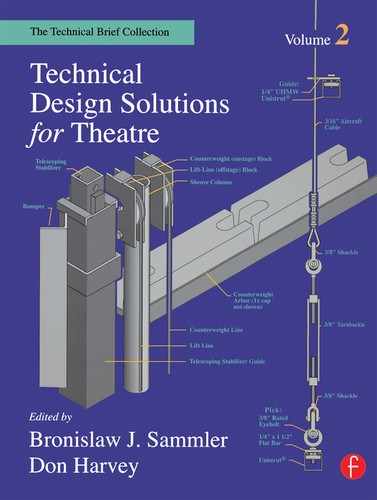Stuart Wheaton |
The World’s Brightest Glowing Thing |
In reviewing the requirements for a dance piece dealing with the life and music of Jim Momson and the Doors, Northern Illinois University Resident Lighting Designer Mark C. Williams casually remarked, “and then the dancer holds up ‘The Worlds Brightest Glowing Thing.’” Marks objective was to symbolize the short, bright candle of Momson’s life with an effect that had the intensity of burning magnesium. But the Lighting Designer’s objective left the Master Electrician (me) with two questions: “What is The World’s Brightest Glowing Thing?” and “How is it powered?”
The Thing was to be smuggled onstage by a dancer in the corps and passed to the crouched Morrison figure, while the rest of the dancers formed a people-pile around him. Then “Momson” would slowly stand, holding the Thing out in front of him as though offering it to the World. Suddenly, the Thing would throw a brilliant light that would silhouette the dancer against the cyc for just a few moments. Then the light would suddenly go out, and the Thing would be passed to another member of the corps, who would spirit it offstage.
What I needed was an extremely safe and compact source of brilliant light that a dancer could easily trigger and that my novice crew could comfortably and confidently prepare for each show. With all the action of the dance, paging a cable around scenery and through the people-pile would be a major headache, so I was reluctant to use a cabled source. Similarly, given the dancers’ proximity to the effect and the need for multiple handoffs, using a small pyro device was out of the question. My standard stage lamp catalogs offered a few battery-powered possibilities, but the prices were quite prohibitive — and when I examined the potential cost of high-amperage battery packs, I could hear my budget scream.
Just as I was wondering how to tell the Designer “It can’t be done,” one of my former students arrived, needing some help in replacing her burned-out headlight. The replacement lamp didn’t look much like a “normal headlight” to me. It was just an ordinary-looking lamp — you know, like an FEL. I’ve been driving too many old trucks ….
While installing the lamp and cursing the engineer who had designed the headlight housing, I realized that I was holding a perfect, low-voltage, high-intensity point source. If only the power supply could be more convenient than the one that was currently acidifylng my elbow. As I washed up, I thought of the 12v cordless drill I had recently purchased. Surely, driving screws required a healthy amperage. Besides, the effect I needed to power wouldn’t last more than a minute, and my Panasonic EY9001’s battery could be recharged in 15 minutes. So, a few hours later, after convincing a counterperson that “I Really Don’t Care What Car It Fits,” I emerged from the local auto parts emporium $15 poorer but with a 12v 65/45-watt halogen headlamp, type 9004, in my possession.
CONSTRUCTION
After cutting away the lamp’s protective plastic skirt to access the contact pins, I determined the appropriate pin-out with my VOM and then soldered both the hot leads and the common to short lengths of 12-gauge wire. I formed some battery connections by soldering pieces of brass shim stock to more 12-gauge wire and then folded them to provide large, flat surfaces to mate with the battery contacts.
Figure 1 illustrates the wooden project box I built from 1×3 and ¼″lauan. Each side of the box was stapled to the 1×3 base, but the joints between adjacent sides and between the sides and the top were just gaffers-taped so that the crew could easily get to the battery if the need should arise. The dimensions noted in Figure 1 left just enough room for the battery, the bases of the lamp, and a toggle switch. I wired the lamp to the battery and switch through a hole in the box’s lid, and to

FIGURE 1: CONSTRUCTION DETAILS
secure the lamp, I replaced its O-Ring with two pieces of wire that I wrapped around the lamp’s base and twisted together underneath the lid as shown. To protect the envelope from finger contact and to prevent anyone’s being injured if the lamp shattered, I encased the lamp in a cage made of ¼″ mesh hardware cloth, fastening the cage in place with a nylon wire-tie.
COMMENTARY
No practical could have been easier to build, and even the steps I took to allow for trouble-shooting proved unnecessary: I never had to replace the lamp, and the battery never needed a re-charge. Best of all, the unit really did look like “The World’s Brightest Glowing Thing.”
